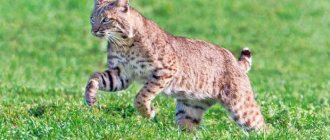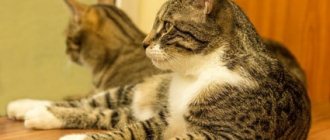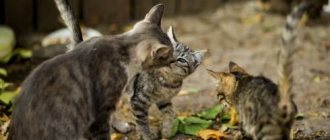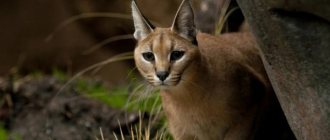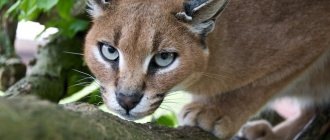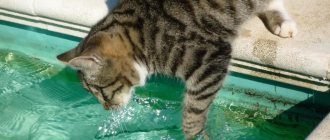The species of lynx has always attracted the attention of lovers of exotic pets.
But not all lynxes can be kept in the house; many of the representatives of the species cannot be tamed. However, with early education and active socialization, the bobcat bobcat may well become a fairly tame animal with the authentic appearance of a wild cat. The wild red lynx is a distant relative of the common lynx. So distant that now species do not even interbreed, either in the wild or in zoos.
The bobcat lives in the United States and Canada, and is sometimes found in southwestern Mexico. The red lynx came to the mainland back in the Pleistocene era through the Bering Strait. It was after migration that the red lynx began to form as a separate species of lynx, although initially it was very close to the Eurasian lynx.
Varieties and prices
- Common lynx - from 90,000 rubles.
- Canadian lynx - from 40,000 rubles.
- Iberian lynx are almost impossible to acquire legally, they are classified as CITES 1 and trade is permitted in exceptional circumstances.
- Red lynx - from 50,000 rubles.
However, wild species may be difficult to domesticate. And through crossing, special breeds were bred with a softer disposition and good tamability. In terms of price, they are the most expensive.
Caracal (Steppe lynx) - from 400,000 rubles. Due to its strong external resemblance, it was considered one of the lynx species, but at the moment it is separated into a separate genus. With proper upbringing, kittens grow into kind and playful adults.
Caracal
Karaket - 500,000-1,200,000 rubles. A mixture of caracal and domestic cat. A friendly and peace-loving breed, sometimes too independent, but non-aggressive. The most valued hybrids are the first generation, whose cost can exceed a million rubles; they are also the most similar to lynx.
Caraquet
Domestic lynx - 400,000-1,000,000 rubles . A cross between a Canadian lynx and a domestic cat. In appearance it resembles its wild ancestor, and from the cat it inherited a gentle playful character and affection for humans.
Among other things, there are lynx-like breeds . They resemble lynxes, but have a different origin. An undoubted advantage will be the relatively low price and almost domesticated species. Keeping these animals does not require large areas of premises and does not carry the risks that exist when living with a wild animal:
- Norwegian forest cat - 12,000-80,000 rubles. and higher. Despite their large size and powerful physique, Norwegian cats are distinguished by their kind, calm character. They even get along with noisy children and other animals, such as dogs. Their intelligence and cheerful disposition make them excellent companions.
- Siberian cat - 8,000-18,000 rubles. The result of love between wild cats that lived in the Trans-Urals and oriental breeds. Due to the harsh climate, they have thick fur, and the tufts on their ears indicate wild relatives. A distinctive feature of this breed, in addition to its friendly nature, is its attachment to one owner.
- Maine Coon - 20,000-90,000 rubles. According to one version, they appeared as a result of mating a North American lynx with an ordinary cat.
- Pixie bob - 30,000-100,000 rubles. A very rare and young breed. Has a “dog” character and loves water. Extremely smart, calm in character. He does not tolerate change well and quickly runs wild without contact with people.
- American bobtail - 35,000-100,000 rubles. Very loving animals, they are distinguished by intelligence and resourcefulness, for example, they can independently get out of a closed cage
- Kurilian bobtail - 15,000-80,000 rubles. The homeland of these cute animals is the Kuril Islands. If you are looking for an intelligent, cheerful, and loyal friend, then this is the breed for you.
Kurilian Bobtail
A formidable or gentle predator in the house
This graceful forest animal surprisingly easily gets used to people. But it is advisable to get a lynx at a young age. Lynx kittens are very playful and will always delight their owners with funny antics. You will need to get used to this, since these little predators can very quickly restore such “order” in the apartment that it will take a long time to clean it. Did you know that cats are friends with dogs? But, if this option is not yours, read an interesting article on how to teach a cat to be friends with a dog.
What to feed a lynx?
You need to feed the lynx correctly. A large individual eats four hundred grams of raw meat at a time. And you need to feed your spotted pet twice a day. In addition to meat, the lynx happily eats dry food and canned fish. But you need to gradually accustom your predator to canned food. In addition, it is imperative to add various vitamins, as well as minerals and calcium to your food. Well, find out what to feed another predator, the ocelot, in this article.
How does a lynx get along with children?
Lynx gets along very well with children. And besides, she can become a real nanny for the baby. The most interesting thing is that children can pull their pet's whiskers and tail. In response, the lynx will steadfastly endure all the “bullying of the little master.” But he does not forgive adults for insults. That's why you can't beat him. Since the lynx will take revenge for these blows for a very long time and cruelly.
A young male needs to be castrated, otherwise there will be a very specific smell in the apartment. And finding a match for your pet will be almost impossible. Do you know what happens to your cat’s character after castration? Read this article.
In general, keeping a predator at home is very difficult. First of all, it's a big creature. And secondly, very often this pet exhibits hunting instincts. And then problems will arise for all living beings in the area.
Watch how a domestic lynx plays with its owner.
Did you like the post on the Red Cat website? Click on the buttons below if you liked the article. Please press everything one by one, thank you!
Source
Continuation of the family lynx
Reaching sexual maturity in these animals begins at six months of age; in some individuals, puberty lasts up to one and a half years; according to some sources, caracals can reproduce effectively if their body weight exceeds 9–11 kg. It is impossible to say for sure about the exact beginning of the mating season; mating can occur all year round, but these animals show the greatest sexual activity from mid-autumn to the end of winter, since during this period there is an abundance of food in the territory they occupy and they have enough time and energy for reproduction.
The mating season of the steppe lynx is very interesting; it is always supported by mating games and alluring gestures. So, during the breeding season, female representatives begin to secrete specific substances along with urine - pheromones, which do not produce any attractive effect on individuals of the opposite sex. Males, in turn, must give a kind of signal that notifies the beginning of the mating season, while they make sounds reminiscent of coughing. The mating process in this species of animal usually lasts for several days, and the female is rarely limited to just one male; as a rule, she chooses for herself older, larger and, one might say, accomplished “male” lynxes.
The role of the male in the process of reproduction of offspring is only fertilization, then the expectant mother takes everything into her own hands and under her own responsibility. The duration of pregnancy in caracals is approximately 2–4 months; towards the end of this period, the female begins to search for a secluded place to give birth. Most often, such places are burrows forgotten by everyone, old remote caves or cavities under tree rhizomes. It is in such fertile places that steppe lynx cubs are born; in one litter there are from 1 to 7 kittens. In the first days of life of these “babies”, their responsible mother constantly tries to change their place of residence, dragging her offspring, this is all for their safety, such daily moves continue until the kittens reach one month of age. When babies (little lynxes) turn six months old, they gradually begin to leave their parents' nest and begin to settle into their adult and independent lives.
Caracal protection
The African population of caracals is described in Appendix II of CUTEC, but the Asian populations are described in Appendix I of CUTEC. In this regard, hunting such animals is prohibited in many countries in Asia, as well as Africa. As for the Namibian and South African populations, caracal hunting is permitted here only to protect livestock.
In addition, it is believed that these predatory animals are on the verge of extinction in other countries, such as Pakistan, Jordan, and northern Africa. However, populations are at a stable level in southern and central Africa. The caracal trade is practiced in many countries around the world. Here they are kept as pets. These are countries such as the USA, Russia, Canada and the Netherlands. Although the scale of trade is quite small, there is a tendency that the scale of trade in these animals may increase.
Caracals have been listed as Least Concern by the IUCN since 2002. This animal lives in 50 countries around the world where there are no threats to the continued existence of these predators. Naturally, trends in human development are increasingly negative for living nature. The number of people living on our Planet is increasing, so the intensity of their interference in the natural environment is increasing, which negatively affects its inhabitants.
Steppe lynx: keeping at home
People bred such amazing pets as caracals in their homes for a very long time, only in ancient times they did this so that later this domesticated predator would help them get food for them and their families. The domestic lynx was once the lot of poor people, so it was once called “the poor man’s cheetah,” but now its status in the world of pets has changed a lot and it can safely be called “the cat for wealthy people.”
Peculiarities of behavior of the domestic lynx in nature
In its native habitats, this beautiful predator is active mainly at night, but when spring comes, the caracal cannot deny itself, during the day, to admire the time when everything around is blossoming and transforming after the winter rest. In addition, it can be active during the daytime in winter, since during this not entirely favorable period of the year, there is sometimes a shortage of food products, so this animal has to sacrifice its rest in order to have more time to hunt.
These wild creatures most often choose crevices in rocky rock as their personal home. But if luck turned his way, and on his way he happened to stumble upon a hole that was built by some fox or porcupine, the caracal would happily settle there, no matter how it was a ready-made house, and not some kind of cavity in the stone. A graceful cat can live in such burrows for many years. The territory occupied by these peculiar lynxes is quite large in area, especially for male representatives; usually two to three times more space is allocated for them than for female lynxes, and they must always live in the central parts of their habitats. Females will be more modest, and they are quite happy with the periphery and even the outskirts.
It very rarely happens that this mammal remains hungry, as by nature it did not inherit some talent for the hunting craft. Although his long, muscular legs do not allow him to run for too long, he has a gift for making big jumps. In addition, this elegant predator simply has an extraordinary reaction speed and as soon as prey appears in its field of vision, it is immediately overtaken by the full power of the animal’s body and sharp claws. A caracal can easily grab a couple of birds for itself from a flock that is just preparing to take off. We can say that this handsome man does not like to share with his relatives and neighbors at all, for this reason, immediately after catching his lunch, he takes it high on a tree and already there, in splendid solitude, enjoys his meal.
The diet of the steppe lynx consists exclusively of products of animal origin; it can happily eat small antelope, predatory animals, for example, a fox or mongoose; in addition, the caracal often hunts a variety of rodents, hares, reptiles, porcupines and ostriches. If this cunning man lives near agricultural holdings, then he can easily afford to steal poultry, a kid or a lamb. A lynx can live without water for a relatively long time; the lack of fluid in the body is usually compensated by succulent food.

